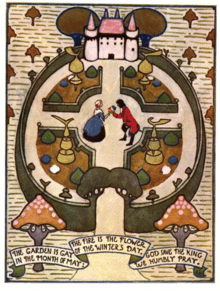Arabella Rankin
Arabella Louisa Rankin (1871 – 1943) was a Scottish painter and colour woodcut artist.[1]
Arabella Rankin | |
|---|---|
| Born | 1871 Muthill, Perthshire, Scotland |
| Died | 1943 Kensington, London, England |
| Nationality | British |
Early life
Rankin was born at Muthill in Perthshire.[2]

Career
Rankin contributed a story, "Kaitrin's Collection", to the 1893 Summer Number of the Dundee Weekly News.[3][4] In 1896, Rankin also won first prize in a contest for artful embroidered book covers, run by Studio International magazine, with her Podley.[5] She also won first prize in a contest run by the same magazine in 1902, for a color illustration titled Sir Espérance.[6] In 1899, her watercolour titled "A Swimming Match" was exhibited at the Royal Scottish Academy in Edinburgh.[7]
Beyond these very early efforts, Rankin worked primarily with colour woodcuts. Early examples of her prints, such as The Striped Rocks (1920)[8] or Sligneach, Iona (1921),[9] show her using Japanese wood block techniques.[10] Later landscape works, such as Martyr's Bay, Iona and Iona, from 1924 and 1927 respectively, use a more conventional approach.[10]
Rankin was a member of the Colour Woodcut Society and from 1924 to 1935 exhibited regularly with the Society of Graver Painters in Colour.[10] During her career she had some twenty-four pieces shown at the Royal Scottish Academy and also exhibited with the Society of Women Artists, and the Royal Glasgow Institute of the Fine Arts.[2][11]
Personal life and legacy
After a spell in Edinburgh, Rankin worked in London for a time. She returned to Scotland in 1913 and lived at Abbotsbrae in Crieff before returning to London in 1922. She lived in Kensington for the rest of her life.[2][12]
Both the Victoria and Albert Museum and the British Museum hold examples of her prints.[13][14]
References
- Paul Harris & Julian Halsby (1990). The Dictionary of Scottish Painters 1600 to the Present. Canongate. ISBN 1-84195-150-1.
- Peter J.M. McEwan (1994). The Dictionary of Scottish Art and Architecture. Antique Collectors' Club. ISBN 1-85149-134-1.
- "The Summer Number of the Weekly News (advertisement)". The Courier and Argus. 1893-06-20. p. 7. Retrieved 2020-05-05 – via Newspapers.com.
- "Dundee Weekly News Summer Number". The Courier and Argus. 1893-06-12. p. 3. Retrieved 2020-05-05 – via Newspapers.com.
- "Embroidered Book Cover". The International Studio. 6: 197. 1896.
- Holme, Charles; Boswell, Peyton; Eglington, Guy; McCormick, William Bernard; Whigham, Henry James (1902). "Awards in 'The Studio' Prize Competitions". The International Studio. 16: 230.
- "Scottish Academy; Annual Exhibition". The Courier and Argus. 1899-02-25. p. 4. Retrieved 2020-05-05 – via Newspapers.com.
- "The striped rocks | Rankin, Arabella Louisa | V&A Search the Collections". V and A Collections. 2020-05-05. Retrieved 2020-05-05.
- "Sligneach, Iona | Rankin, Arabella Louisa | V&A Search the Collections". V and A Collections. 2020-05-05. Retrieved 2020-05-05.
- Robin Garton (1992). British Printmakers 1855-1955 A Century of Printmaking from the Etching Revival to St Ives. Garton & Co / Scolar Press. ISBN 0-85967-968-3.
- Grant M. Waters (1975). Dictionary of British Artists Working 1900-1950. Eastbourne Fine Art.
- Simon Houfe (1996). The Dictionary of 19th Century British Book Illustrators. Antique Collectors' Club. ISBN 1-85149-1937.
- "Collection search, Arabella Louisa Rankin". British Museum. Retrieved 25 February 2019.
- "Arabella Louisa Rankin". Victoria & Albert Museum. Retrieved 25 February 2019.
External links
- "Arabella Rankin: Iona" Modern Printmakers (29 July 2012); a blogpost by Haji Baba, about the artist.
- Arabella Rankin, "The Merry Men, from Iona" (c. 1920), in the Victoria & Albert Museum.
- Arabella Rankin, "Calva, Iona" (c. 1920), in the Victoria & Albert Museum.